

Black-women-people-of-colour-racism-beyonce-coachella-black-lives-matter-a8316561. The biggest Black Lives Matter page on Facebook is fake. The page, titled simply "Black Lives Matter," had almost 700,000 followers on Facebook, more than twice as many as the official Black Lives Matter page.
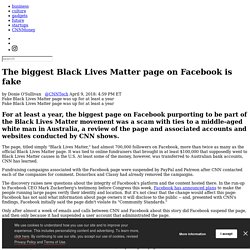
It was tied to online fundraisers that brought in at least $100,000 that supposedly went to Black Lives Matter causes in the U.S. At least some of the money, however, was transferred to Australian bank accounts, CNN has learned. Fundraising campaigns associated with the Facebook page were suspended by PayPal and Patreon after CNN contacted each of the companies for comment. Donorbox and Classy had already removed the campaigns. The discovery raises new questions about the integrity of Facebook's platform and the content hosted there. Only after almost a week of emails and calls between CNN and Facebook about this story did Facebook suspend the page, and then only because it had suspended a user account that administrated the page.
Indeed, Facebook was told of concerns about the page some time ago. Mediapart - ⏪ [REPLAY] – La réalisatrice Amandine Gay... Fox News During The Civil Rights Movement. Posted on June 1, 2009 in Political Cartoons See Also: Thoughts on FOX.

The March on Washington, 1963: Photos of the Epic Civil Rights Event. Civil Rights Movement '60s So many scenes from the August 28, 1963, March on Washington are now familiar to so many of us — and the cadence of Martin Luther King Jr.’s “I Have a Dream” speech is so much a part of the national consciousness — it’s easy forget that for the hundreds of thousands of people who marched and rallied that day, the event was wholly, thrillingly new.
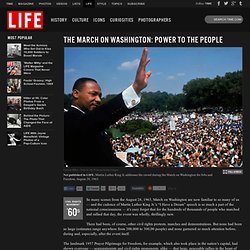
There had been, of course, other civil rights protests, marches and demonstrations.
PREMIERES - TOPIC 2 - KEY DATES AND EVENTS - JACOBANGLAIS, le blog d'anglais du Lycée Jacob Holtzer. I.
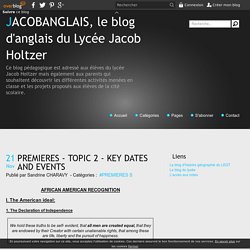
The American ideal: 1. The Declaration of Independence The Declaration of Independence, adopted by Congress on July 4th 1776 2. The Constitutional Convention was held to list problems in governing the USA after the Declaration of Independence. Many issues were discussed during the convention: Underground Railroad Student Activity. The Underground Railroad: Journey to Freedom - National Geographic Education. Mississippi burning worksheet. Civil Rights Course in Full Operation at FBI Academy.
Martin Luther King, Jr.’s life, legacy, and a visit to the civil rights leader’s national memorial in Washington, D.C. are part of a course at the FBI Academy.
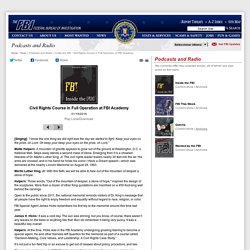
[Singing]: “I know the one thing we did right was the day we started to fight. Keep your eyes on the prize, oh Lord. Oh keep your keep your eyes on the prize, oh Lord.” Mollie Halpern: A mountain of granite appears to grow out of the ground at Washington, D.C.’s National Mall. Steps away stands a second mass of stone. Martin Luther King, Jr: With this faith, we will be able to hew out of the mountain of despair a stone of hope. Halpern: Those words, "Out of the mountain of despair, a stone of hope," inspired the design of the sculptures. Open to the public since 2011, the national memorial reminds visitors of Dr.
FBI Special Agent James Hicks remembers his first trip to the memorial around this time last year. James H. Halpern: At the time, Hicks was in the FBI Academy undergoing grueling training to become a special agent. Mark A. Black history in the US. From MLK to ObamaUne séquence complète niveau 3ème proposée par Catherine Court-Maurice (Collège Le Chapitre) file_download Télécharger la séquence Black history Month (Time for Kids)Dossier très complet conçu pour de jeunes américains pour Black history month en février : Then and Now : timeline The fight for rights : texte et jeu Now hear this : discours de MLK, JFK et Lyndon Johnson The arts Infographie : From slavery to ObamaLes dates les plus marquantes (utilisé dans le cadre d’une étude du tableau The Problem We All Live With, de Norman Rockwell).Infographie réalisée à l’aide de la version gratuite d’Easel-ly.

Pause image : Strange Fruit, Billie Holiday. Lincoln et la fin de l'esclavage aux Etats-Unis. La réélection de Lincoln, en 1864, candidat du parti Républicain, se traduisit par l’abolition de l’esclavage aux États-unis.
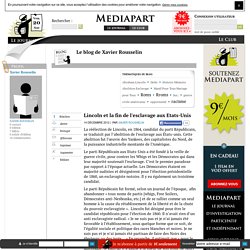
Cette abolition fut l’œuvre des Yankees, des capitalistes du Nord, de la puissance industrielle montante de l’Amérique. Le parti Républicain aux Etats-Unis a été fondé à la veille de guerre civile, pour contrer les Whigs et les Démocrates qui dans leur majorité soutenait l’esclavage. C’est le premier paradoxe par rapport à l’époque actuelle.
Les Démocrates étaient en majorité sudistes et désignèrent pour l’élection présidentielle de 1860, un esclavagiste notoire. Il y eu également un troisième candidat.
Chronologie de l'esclavage aux États-Unis. Arrivée du premier esclave aux États-Unis.
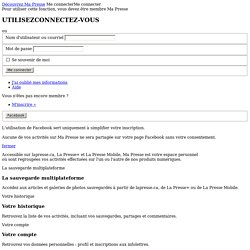
Augmentation phénoménale de la traite des esclaves, tous des Africains kidnappés. L'État du Massachusetts adopte une première loi anti-esclavage. La Grande-Bretagne abolit la traite des esclaves. Les États-Unis considèrent désormais la traite (la vente) des esclaves et le kidnapping d'Africains comme un acte de piraterie (donc passible de mort), mais n'abolissent pas l'esclavage. L'esclavage est officiellement aboli dans les États du Nord. Adoption de la «Black Law» au Connecticut: elle interdit l'enseignement aux Noirs, mais surtout, elle stipule qu'un esclave qui a réussi à fuir le Sud pour venir vivre dans le Nord des États-Unis doit être remis à ses maîtres s'il est capturé.